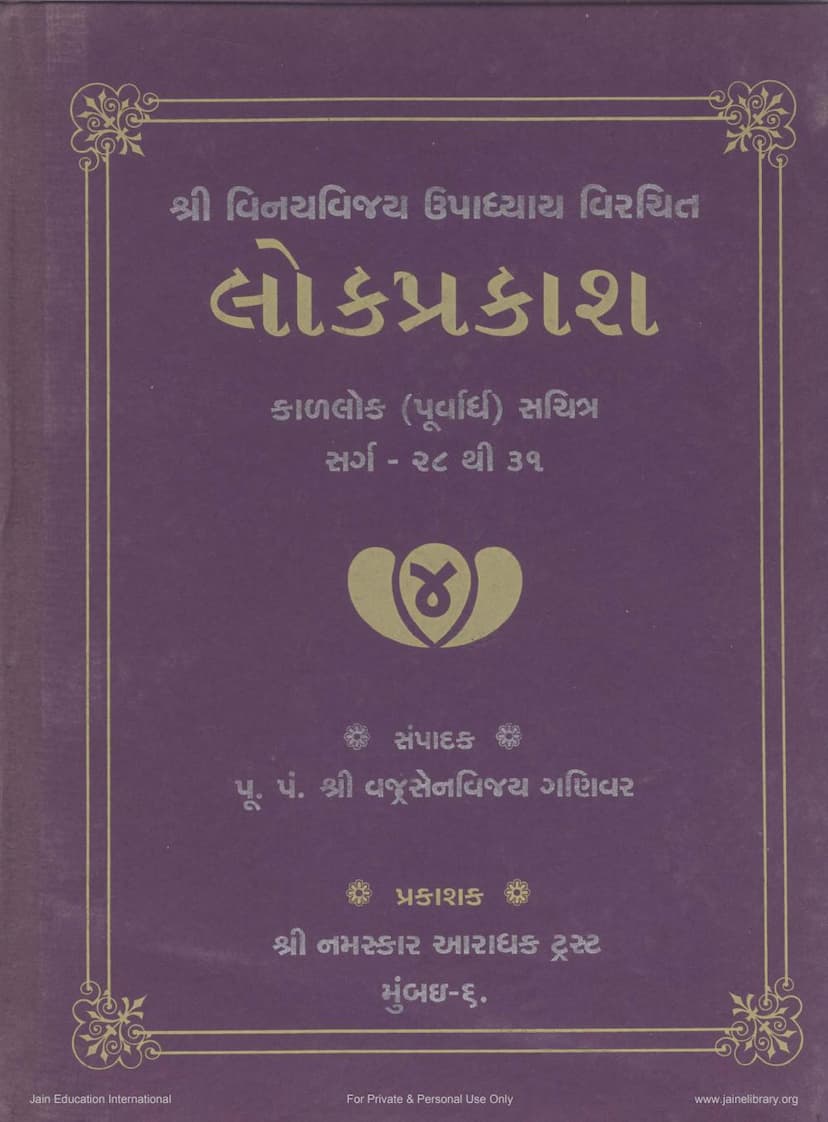Lokprakash Part 04
Added to library: September 2, 2025

Summary
A comprehensive summary of the provided Jain text, "Lokprakash Part 04 - Kalalok (Purvardha)" by Kunvarji Anandji Shah, published by Namaskar Aradhak Trust, Mumbai, is as follows:
This volume, "Kalalok (Purvardha)," is the fourth part of the larger work "Lokprakash," originally authored by Upadhyay Vinayvijay and meticulously compiled and translated by Kunvarji Anandji Shah. The current edition is published by Namaskar Aradhak Trust, Mumbai. The work is dedicated to various Jain Tirthankaras and revered spiritual masters.
The volume specifically covers chapters (Sargs) 28 to 31, focusing on the concept of "Kalalok" (Time Realm) in Jain cosmology and philosophy. It delves into the intricate details of time, its measurement, and its influence on the universe and living beings, from a Jain perspective.
Key Themes and Content:
-
The Nature of Time (Kal): The text begins by exploring the concept of time (Kal). It discusses whether time is an independent substance (dravya) or merely a manifestation of the qualities and activities (paryay) of substances like soul (jiva) and non-soul (ajiva). Various arguments are presented, referencing scriptures and learned opinions to establish time's existence, either as a distinct entity or as a crucial concept for understanding the universe. The text distinguishes between different types of time, such as temporal time (vartana), consequential time (parinam), action (kriya), and relative time (paraparattva).
-
Time Measurement: A significant portion of the text is dedicated to the complex systems of time measurement used in Jainism. This includes:
- Units of Time: From the most subtle unit of time (samay), it explains the progression through aavali (a very short duration), praana (life breath), muhurta (an hour), ahhoraatra (day-night), paksha (fortnight), maas (month), rutu (season), varsha (year), and finally, the vast Yuga cycles.
- Solar and Lunar Calendars: The text details the calculations and distinctions between solar (Suryavarsh) and lunar (Chandramaas) calendars, including the concept of Adhik Maas (intercalary month) to synchronize them. It explains how these calendars are used to track cosmic events and religious observances.
- Astronomical Concepts: Discussions on the movement of celestial bodies like the Sun and Moon, their influence on time, and their relation to constellations (nakshatras) are provided. It explains the significance of various nakshatras and their relation to months.
- Tools for Measurement: The text elaborates on the use of instruments like the Tula (balance scale) for measuring substances, which indirectly relates to time measurement in astronomical contexts. It also describes the construction and function of various yantras (diagrams or instruments) used in Jyotish (astronomy/astrology).
-
The Six Aryas (Periods of Time): The text meticulously describes the six Aryas of time as per Jain cosmology: Susama-Susama, Susama, Susama-Dushama, Dushama-Susama, Dushama, and Dushama-Dushama. It details the lifespan, physical characteristics, and societal norms of beings in each Arya during the descending (avasarpini) and ascending (utsarpini) time cycles. The initial Aryas are characterized by happiness, virtue, and lack of suffering, while the later Aryas see a decline in these aspects, leading to the rise of human flaws and the need for societal structures and laws.
-
The Lives of Great Souls (Shalaka Purushas): The text touches upon the concept of Shalaka Purushas (distinguished individuals), including Tirthankaras, Chakravartis, Vasudevas, Baladevas, and Prativasus. It provides details about their birth, attributes, and significant events in their lives, often referencing the Jain Puranas. The text explains how their actions and qualities are tied to their spiritual development and their role in shaping the temporal realm.
-
The Concept of Rents (Seasons) and Months: The text describes the six seasons of the year (Rutu) and the names of the months associated with both the solar and lunar calendars. It explains the cyclical nature of time and how seasons influence life and activities.
-
Rituals and Practices: The text mentions certain rituals and practices, such as the preparation and offering of food, the importance of certain auspicious timings for events, and the veneration of the Tirthankaras. It touches upon the concept of 'Paushadh Vrat' (a fasting observance) and its various aspects.
-
The Nature of the Universe: While primarily focused on time, the text also provides glimpses into the Jain understanding of the universe, including its various realms (lok), the celestial bodies, and the beings residing in them.
-
The Importance of Knowledge and Action: Throughout the text, there's an underlying emphasis on the importance of right knowledge (samyakdarshan), right conduct (samyakchaitra), and right faith in understanding the Jain philosophy, especially concerning time and karma.
-
Subtle Astronomical Calculations: The text demonstrates the Jain tradition's profound understanding of astronomy with detailed explanations of calculations related to time units, celestial movements, and their impact. The meticulous nature of these calculations reflects the Jain emphasis on precision in understanding the cosmos.
Overall Significance:
"Lokprakash Part 04 - Kalalok (Purvardha)" serves as a valuable resource for understanding the Jain perspective on time, cosmology, and the cyclical nature of existence. It showcases the depth of Jain knowledge in astronomy and mathematics, as interpreted through their spiritual framework. The work aims to provide a clear and structured understanding of these complex concepts, making them accessible to its readers. The inclusion of detailed calculations and the reference to various Jain scriptures highlight the rigorous intellectual tradition within Jainism.